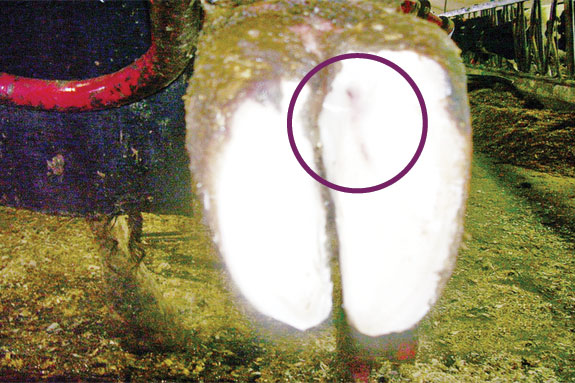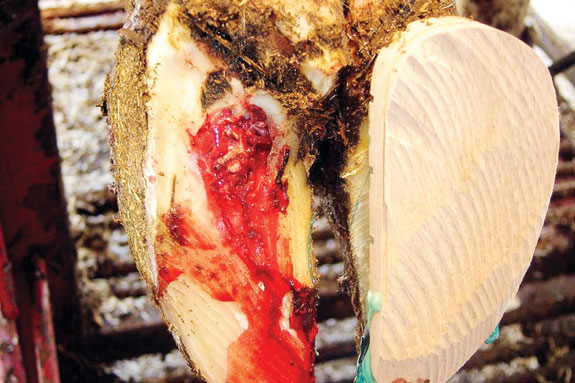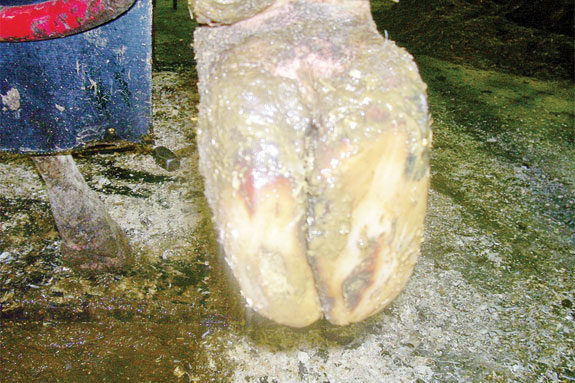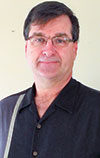After more than 28 years working as a hoof trimmer in the dairy industry and, like many others, seeing the many changes within the dairy industry, a simple question must be asked: “Why is lameness increasing as an issue?” The answer is the modern dairy industry still has not recognized the requirements for the hoof to function “normally.”
Despite all the advances in technology promoting animal productivity through cow comfort – such as barn stall design, ventilation, water supply, etc. – lameness has become the number one animal welfare issue for the dairy industry. In order for the cow’s hoof to function normally, certain requirements are needed.
These include sound nutrition, minimal stress and genetics that allow adequate feet and leg structure. Most important, though, is an environment that will allow the sole of the hoof to shed, enabling the outer walls to wear, creating a functional shape to provide the animal a comfortable gait.
There are three components to the claw itself. The outer walls, being the hardest and weight-bearing, absorb the least amount of moisture. The white line, which binds the sole to the outer walls, is weakest and absorbs the most moisture. Finally, the sole, which is the key to normal function, is of medium strength and moisture absorption.
The sole of the claw is designed to “shed” hoof material as the hoof grows relative to its growth-to-wear rate. In a pasture environment, shedding occurs naturally and the sole is generally 3 to 8 millimeters above the outer walls of the claw.
However, our current trend toward confinement systems, such as freestalls with concrete floors allowing animal mobility, creates a very moist environment for the cow’s hoof due to animal excrement on the alleyways. This moisture prevents the sole from drying and shedding.

So the buildup of the sole becomes weight-bearing, rather than the outer wall as in nature. As the sole or claws become uneven, the pedal bone, or P3, can bruise the corium of the foot due to concussion of the hoof on the concrete floor.
That bruise, called a hemorrhage, can become an ulcer that negates animal well-being and profit.
In a tiestall barn, we find the reverse. This dry hoof environment, which restricts mobility, allows the sole to build up and, by the force of compression, form the same hemorrhage, which can lead to an ulcer.
I advise, from a biomechanical point of view, that the key to good hoof trimming is the technique of trimming on time. As an early adopter of computer recording of foot health, I have benchmarked all my herds.
I have developed scheduling strategies to target the elimination of ulcers as the No. 1 or No. 2 most dominant lesion to now the third- or fourth-ranking lesion in a herd. Many of my herds have been adjusted to a four- to six-week-earlier trimming session with very positive results that have made the farm money.
A herd trimmed every six months with a 15 percent herd ulcer rate trimmed six weeks earlier drops to a 5 percent cow ulcer rate with reduced incidence severity.
Dr. Temple Grandin has suggested the goal to reduce lameness in dairy herds to 10 percent or below. Accepting Grandin’s challenge, I have developed a simple economic index for my clients that I call the TCI (Trimmer Cost Index). TCI accounts for a herd’s routine maintenance trimming costs and its variable treatment costs.
A herd’s TCI is calculated by first multiplying the number of cows trimmed (# of cows) by the trim base price per cow (TBP). This total represents the minimum cost to trim a herd regardless of how frequently the herd is trimmed and without treating for any serious lameness cases.
This total is assigned a TCI of 1, or a perfect score, since it represents 100 percent of the costs of maintaining good hoof health. Most herds when trimmed will have some cows treated for lameness.
These are also accounted for in the index by determining the cost to treat lameness (COT), including wraps, blocks, etc., as a percent of the base cost described above. This is added to the starting TCI index score of 1. Thus, Grandin’s goal of a 10 percent lameness treatment incidence would ideally yield a TCI of 1.1, 10 percent treatment costs above maintenance.
For example, for a 50-cow herd, my TBP is $15, so 50 cows x TBP = $750. Multiply that figure by the targeted rate of treatment for lame cows (i.e., blocks and wraps) at 10 percent yields a goal for treatment cost of $75. That gives the farm a target bill of $825 ($750 plus $75).
Let’s say the value of the COT ($75) was based on three blocks and five wraps. This means the average trim cost per cow is $16.50 ($825/50 cows) when the farm has a lameness treatment rate of 10 percent.

I find that every sole hemorrhage caught by earlier trimming saves progression of the hoof toward a sole ulcer, which I estimate costs about $500 over time to treat.
So I try to explain to this 50-cow dairyman that regular, often earlier, maintenance trimming is probably saving him as much as $3,500 in extra treatment costs.
If, for example, we take the same 50-cow herd and extend time to trimming by six to eight weeks, allowing more biomechanical damage to occur, the index and the dairy’s costs work as follows: 50 head x TBP = $750 (no change) x COT (10 blocks, 15 wraps) = $275, a 36 percent COT; TCI of 1.36; or $20.50 average trim cost per cow.
This shows a significant increase in hoof health costs due to more lameness treatments, which compound over time and cost the dairy significantly.
These two cost comparisons required no change in trimmer, barn, feed, ventilation, etc. However, it does show trimming frequency can have a positive return. Farm managers need to abandon hoof trimming as a cost center and switch to a return-on-investment perspective. The TCI helps do that.
I estimate that for every dollar my clients spend in trimming maintenance, they get a $3 return when they have a 1.1 TCI. Healthier hooves allow the trimmer to spend more time trimming subclinical lameness cows.
Using the TCI and a complete team approach to trimming, including the owner, veterinarian, nutritionist, hoof trimmer and hoof records will create positive hoof health. PD
PHOTOS:
TOP RIGHT: About to be trimmed on time, the outside (lateral claw) of this hoof is overgrown at the sole horn area.
MIDDLE RIGHT: The same claw with excess horn removed revealed an underlying hemorrhage, saving the farm $500 if this hoof had not been trimmed and developed an ulcer.
BOTTOM RIGHT: A hoof being treated for an ulcer because the same overgrowth shown above was not trimmed on time. Photos courtesy of Vic Daniel.

Vic Daniel
Hoof Trimmer
Vic’s Custom Clips
vdaniel1@sympatico.ca







